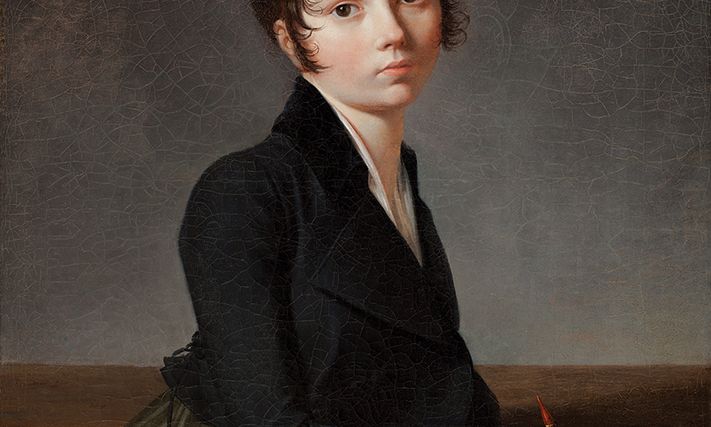Lethière’s output includes portraiture such as Woman Leaning on a Portfolio (1799)
Worcester Art Museum/Bridgeman Images
This massive volume has been published to accompany the first ever exhibition devoted to Guillaume Lethière (1760-1832), a mixed-race, Caribbean-born artist who became a leading figure in the French art world. Guillaume Lethière includes seven essays on different aspects of his life and career, together with catalogue entries for 61 paintings, drawings and prints by (or after) Lethière, and brief details of 51 “works by other artists”. It also features four appendices, a chronology and countless illustrations.
This lavish treatment is, of course, at least partly prompted by Lethière’s exceptional status as an artist of African heritage working within Europe during the era of slavery and colonialism. For the most part, however, his work does not reflect his Caribbean origins but rather conforms to the prevailing norms of Neo-Classicism. He had an enduring fascination with two ancient Roman subjects: Brutus condemning his sons to death and the death of Virginia. His repertoire also included portraiture and landscape.
Lethière’s The Oath of the Ancestors (1822), in the Musée du Panthéon National Haïtien, could not travel in time for the Clark Art Institute show opening because of gang violence in Haiti
Photo: Gérard Blot, RMN-Grand Palais/Art Resource, NY
Unsurprisingly, the book jacket features the one picture by Lethière that not only reflects his Caribbean origins but also testifies to his abolitionist sympathies. The Oath of the Ancestors (1822) commemorates the alliance in 1802 between Black and mixed-race rebel forces during the Haitian Revolution, which overthrew French colonial rule and brought about the abolition of slavery. The painting, which was presented by the artist to the fledgling nation in 1823, sadly is absent from the exhibition at the Clark Art Institute in Williamstown, Massachusetts (until 14 October), owing to the ongoing violence in Haiti. (The show moves to the Louvre, from 13 November-17 February 2025.)
The first essay, by the Clark’s chief curator, Esther Bell, outlines Lethière’s biography. The Guadeloupe-born son of a white plantation owner and an enslaved woman of mixed race, he benefited from the support of his father, who brought him to France in 1774 and legally recognised him as his heir in 1799, after revolutionary legislation had made it possible to do so. After this point, the artist was entitled to use his father’s surname, Guillon, in addition to Lethière, which simply identified him as a third child.
Bell skilfully draws out the tensions in Lethière’s life and career. She points out that his inheritance meant that he became a slave owner in his turn while nevertheless proudly identifying himself as a person of colour and supporting the abolitionist cause. It is unfortunate, however, that, in her opening discussion of an 1845 map of Guadeloupe, she misidentifies the figure of a sailor in white trousers, striped shirt and straw hat, surrounded by packing cases, in the ornamental margin of the map as a “well-dressed dandy… likely the proprietor of the plantation picture above”.
The historian Frédéric Régent explores Lethière’s identity as a “free person of colour” in the context of the racial prejudices of the period and of the struggles for emancipation during the French Revolution. The irony here is that, while the Napoleonic era saw the reinstatement of slavery in the colonies and the revival of racial prejudice, Lethière nevertheless enjoyed the patronage of the Bonaparte family, thanks to whom he was appointed the director of the Académie de France in Rome in 1807.
The Clark’s director, Olivier Meslay, shows that, despite the disadvantages of his birth, Lethière was extremely well integrated into Parisian artistic circles. Marie-Pierre Salé considers the development of Lethière’s drawing practice, while Anne Lafont provides a broad-ranging discussion of the relationship of art and race during his lifetime. As she points out, none of the portraits of Lethière gives any hint of his mixed-race origins. If they are in fact accurate likenesses, then it would surely help to explain why these origins seem never to have held him back.
A recurrent theme is Lethière’s enduring association with people who shared his connection to the Caribbean. They included the revolutionary general Thomas-Alexandre Dumas, who was also of mixed race, and his son, the novelist Alexandre Dumas, both of whom became the artist’s friends. Christelle Lozère explores Lethière’s links to the nascent community of Caribbean artists in early 19th-century Paris. By this date, however, growing racial prejudice led artists of mixed race to conceal their origins.
Another recurrent theme is Lethière’s close relationships with women artists, most of whom had been his students. As C.C. McKee argues, he was something of a pioneer in admitting women students into his atelier (though the same can be said of his supposed rival Jacques-Louis David). Typically, Lethière’s female students either came from or had ties to the Caribbean, as in the case of Hortense Haudebourt-Lescot, who accompanied Lethière’s family to Rome in 1807 and subsequently had a highly successful career.
The catalogue entries include lengthy discussions of key works. The entry for The Oath of the Ancestors, for example, condenses an existing study of the painting by Darcy Grimaldo Grigsby. It is a pity, however, that Lethière’s famous depiction of revolutionary volunteers enlisting in 1792, here called The Homeland is in Danger (around 1799), gets relatively short shrift.
Across the volume, there is a good deal of repetition that could have been avoided if authors had been given a tighter brief. It is nevertheless a monumental achievement.
• Guillaume Lethière, by Esther Bell and Olivier Meslay (eds). Published 2 July by Clark Art Institute/Yale, 432pp, 170 colour & b/w illustrations, £50 (hb)

